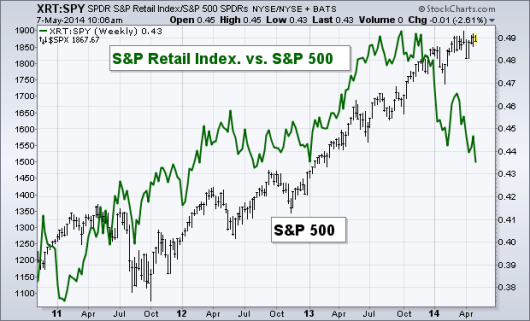Below are the charts showing price (most charts are price only and not dividend adjusted outside of $XLF, which is divided-adjusted) as well as the sector’s respective Advance-Decline Line. The Advance-Decline Line is one of the most commonly used tools to measure the breadth, which is just a fancy way of saying participation, within a market. A-D Lines simply measure the cumulative number of underlying stocks that are rising or falling. When a sector is hitting new highs, ideally you want its breadth measurement to also be in a strong up trend and hitting new highs. It’s when these two diverge that we see a warning sign that the trend may be changing as the level of participation by individual stocks is not showing strong support.
Health Care
The SPDR Health Care ETF ($XLV) is currently trading in a consolidation pattern with resistance around $71.50 and support of a rising trend line connecting the prior higher lows. The A-D Line for Health Care is near a new high and has shown a solid level of support by the underlying health care stocks.
Consumer Staples
$XLP has been in a down trend since its mid-2016 peak, however price has recently broken above the declining trend line as buyers have re-entered the market for consumer staple stocks. The A-D Line for $XLP has been showing a greater sign of strength having risen back to its prior high and is ready to potentially breakout.
Utilities
The utilities sector ($XLU) has been improving since November but still well off its mid-2016 high. Breadth has maintained its up trend for $XLU, not putting in any lower lows like price has over the last 6 months.
Materials
The materials sector has been in an up trend since its early-2016 low and is currently testing a trend line off its intermediate low from November. $XLB’s A-D Line test its prior high but was unable to break out like price had last month.
Consumer Discretionary
$XLY has been setting new highs after putting in an intermediate low in November. However, its Advance-Decline Line has not been able to breakout quite yet – still sitting under its prior August high.
Energy
$XLE had a strong 2016 after declining for several years. However, it’s A-D Line has not been seeing the same level of strength, creating a bearish divergence since for the last several months. While the sector has been rising, it appear many individual energy stocks have not been as lucky.
Financials
Financials have been one of the strongest sectors since the November U.S. election. Price has been attempting to set a new high and the sector’s A-D Line has been support of that attempt, remaining strong and confirming price’s advance.
Industrials
Similar to $XLF, Industrials have been quite strong since the November election with price hitting new 52-week highs. $XLI’s A-D Line has continued to confirm the moves made in price.
Technology
Finally, the last of the S&P sectors and one of the strongest of the group. Technology has continue its up trend and practice of hitting fresh new highs. Fortunately, the A-D Line has continued in its up trend as well. While the A-D Line hasn’t quite broken out like $XLK has most recently, it is very close to doing so.
Update: While Real Estate has been added as a sector, I unfortunately am unable to find an advance-decline line for it, so it has to be left out of this post at this time.
Disclaimer: Do not construe anything written in this post or this blog in its entirety as a recommendation, research, or an offer to buy or sell any securities. Everything in this post is meant for educational and entertainment purposes only. I or my affiliates may hold positions in securities mentioned in the blog. Please see my Disclosure page for full disclaimer. Connect with Andrew on Google+, Twitter, and StockTwits.































